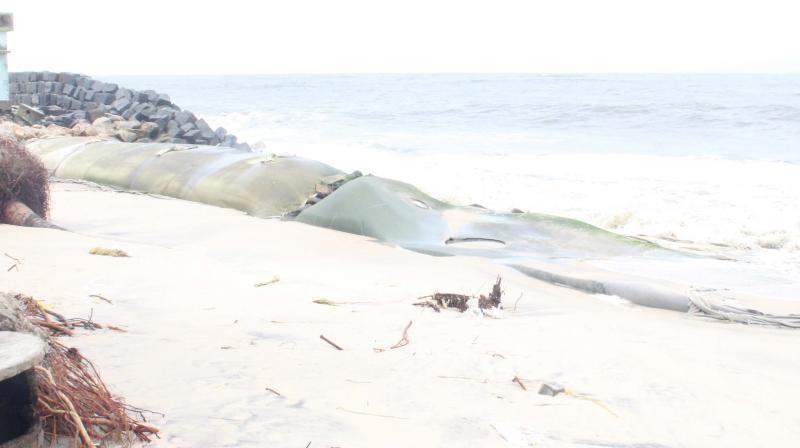Alappuzha: Geotubes successful, but lack maintenance

Alappuzha: At least a hundred homes are under sea erosion thrreat in coastal Meenootu Kadavu here with the southwest monsoon gaining strength.
On Tuesday, five of them shifted to temporary sheds to save life and belongings as high tides started hitting their walls. Their bathrooms and compound wall have already been washed away.
They now pin their hopes on geotube seawalls tested here three years ago to save their shores.
Geotubes laid on a 100-metre stretch had stood guard their property since. But this year, half of it have been destroyed for lack of maintenance.
Kerala Irrigation Infras-tructure Development Corporation Limited (KIIDC) experimented with the geosystem tube technology, spending Rs 60 lakh. Impressed by the performance, it submitted a proposal last year to extend the wall across coastal Alappuzha and Ponnani. But the government is planning to build up 114 groin fields in association with IIT Chennai.
Homemaker Renuka Shaji, 41, who resides close to the geotubes, endorses its ability to resist high tides.
“If these tubes had not been laid here, our property would have been washed away long back,” she says.
“We have taken up the issue of maintaining them with the authorities multiple times, but to no avail. They let it ruin. Now we are seeing unusual signs of sea erosion so early. With the days fall, most of us will become homeless.”
The mother two is pained at the way the authorities treat the coastal folks who saved thousands of lives during the floods last year.
“Everybody wants our expertise when they are in danger, but you can't expect anything in retaurn,” blasts M. Sholy, 43, another resident.
“We would not have ended up in this state if the authorities maintained the tubes in time. They got damaged mainly because of a massive drydock washed ashore in July”
The face of the three-layered tube got pinched due to continuous friction with the base of the heavy drydock kept there for over a week.
Apart from this, thousands of enthusiasts flocked to the site mounted on the tubes to see it.
“All residents here are interested in the tubes. It’s better than laying rocks in the sea,” he said.
R. Rajumon, 35, another resident, believes if the government comes up with a groin field–cum –geo-tube project, the shore can be saved. Groin fields, already laid in Purakkad a few years ago, would help diminish the force of heavy waves.
“The main threat is hitting of pebbles, pieces of heavy rock dumped in the coast as seawall over the years. The waves took pebbles from the sea and bang it on the face of tubes,” he says.
“As a result, it will get damaged. We are told that high-quality tubes which resist the beating of rocks are available in international market. If they are brought in, it will survive long.”

